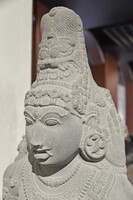| dc.coverage.spatial | Site: Prince of Wales Museum of Western India (Mumbai, Mahārāshtra, India) | en_US |
| dc.coverage.temporal | 12th century (creation) | en_US |
| dc.creator | unknown (Indian (South Asian)) | en_US |
| dc.date | 1100-1199 | en_US |
| dc.date.accessioned | 2016-08-23T18:14:04Z | |
| dc.date.available | 2016-08-23T18:14:04Z | |
| dc.date.issued | 1100-1199 | en_US |
| dc.identifier | 268043 | en_US |
| dc.identifier.other | archrefid: 3395 | en_US |
| dc.identifier.uri | http://hdl.handle.net/1721.3/184355 | |
| dc.description | Detail of kirttimukha headdress and fangs in the mouth; Dvarapala (Sanskrit) is a door or gate guardian often portrayed as warriors with clubs or maces. They are architectural elements, sometimes freestanding, or incorporated into temple door jambs, in both Hindu and Buddhist cultures. They usually appear in pairs either side of the doorway and facing inward. This is one of a pair from a Hindu temple; he stands in the usual pose for these figures, turning to one side with one foot resting on a large club. He wears a tall headdress which is decorated with a monster-mask or kirttimukha; fangs visible at the side of his mouth produce a terrifying image appropriate for a guardian. This is a Shaiva guardian; he does not hold a weapon, but gives the gesture of vismaya mudra. Source: Grove Art Online; http://www.oxfordartonline.com/ (accessed 4/15/2015) | en_US |
| dc.format.medium | granite | en_US |
| dc.rights | © Scott Gilchrist, Archivision, Inc. | en_US |
| dc.subject | deities | en_US |
| dc.subject | Hinduism | en_US |
| dc.subject | Chola | en_US |
| dc.title | Dvarapala | en_US |
| dc.title.alternative | Door guardian from a Hindu temple | en_US |
| dc.type | image | en_US |
| dc.rights.access | Licensed for educational and research use by the MIT community only | en_US |
| dc.identifier.vendorcode | 7A2-IN-PWM-MAH-A02 | en_US |
| vra.culturalContext | Indian (South Asian) | en_US |
| vra.technique | carving (processes) | en_US |
| vra.worktype | sculpture (visual work) | en_US |
| vra.worktype | jamb figure | en_US |
| dc.contributor.display | unknown (Indian) | en_US |


